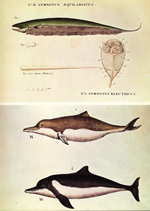Meeting 10/11 • 06/10 February 2014
|
Version: |
|
picture of the week |
|
|
|
mini-text of the week (start): "In Calabozo, in the middle of the llanos, we found an electric machine with great discs, electrophori, batteries and electrometers…"Humboldt, "Personal Narrative", from Jaguars and Electric Eels, ed. & trans. Wilson, pp. 57-8, 62 (read more) |
|
•√ (10') Mini-text of the week: Relation between human beings and Nature, and between mechanical and biological forces and substances. Sometimes the boundaries (or lack of boundaries) weren't understood: 1) Humboldt's battery with the bits of flesh between the disks. 2) Terms like "vitalism", "animal magnetism". 3) Ancient technique of tempering a newly-forged (and still red hot) sword with (human) blood. 4) Astrological (and scientific!) beliefs about the interaction of extra-terrestrial bodies / forces on terrestrial organisms. 5) Anybody know people who use dowsers? •√ Differences among species: Linnean concepts vs. modern cladistics (help from bio, chem and math majors, please!) |
|
•+ (10') Humboldt's enormous contribution to climate science and the origins of sustainabile environmentalism: the Chimborazo research and the iconic diagram – a brief look today, to be followed by a look at some contemporary discussions. How far are we ourselves qualified to judge the science, and how far must we take the "facts" and "data" on "faith"? Why was it so important that Chimborazo had snow on its peak AND was near the equator? •√ Response to previous meeting: How did people become scientists back then? "Be born male". Yes, but let's offset our presentism and consider the difference between obstacles and gateways. Check questions: What factor or feature was the gateway to literacy? (dmbtt / xfbmui) For which classes did being born male or being born female make the greatest differences? How did literacy then differ socially /culturally from literacy now? |
|
•+ (15') triangulation, including hands-on measurements of distances, heights, etc. Pre-Egyptian tools: height of vertical structure (tree, building); distances on the ground, especially in rough territory; why fiddle with barometers to measure the height of a mountain when all that nice trigometry is available? |
|
•N (10') An example of a very different course / project that relates to sustainabilty (and distant lands), and also illustrates how valuable are having many different kinds of knowledge / kills, and also teamwork and individual initiative |
|
•√ (05') Continuation of setup for book review assignment: distribution of next load of books (sign out at end of class); introduction of Stegner reading: what and why |
|
•√ (10') Activation of midterm examination (to be written outside class), with printed copies today. •N Check your progress – and explore the related issues of standards, assessment and grading by exploring this self-evaluation guide for the middle of the term; this applies to your recent writing assignment, to your performance in the course, and to your larger roles as citizen and (possibly) parent. |
|
•N (05') if time: some more apps |
|
• (0') Use your computer/ smartphone map links and applications to trace AvH's route in South America, starting with his travel up the Orinoco and down the Amazon. See Helferich, p. 52 map, but be aware that some place names have been changed over time. Looking further ahead (projects, etc.): presentation (continuation) about educational standards and their parts in the course: 1) evaluating own education; 2) helping others to learn - how standards are used to develop curriculum (curricula?) and learning activities. Example of source of lesson plans; article (H0152) "School Gardens Blooming Teach Lessons On Nutrition, Environment, Science, Teamwork". This is preparation for assignments about species description and group projects. looking ahead: presentation of project ideas (just the ideas, not finished projects) in week •• Later: what it's like to read Darwin; Humboldt-named species; forming teams and scoping out projects (ideas for group projects); the iconic graphic of Chimborazo; apps Humboldt would have liked; what shall we do with (to??) the people who haven't revealed their interests and strengths and don't get "on board" when they're needed? |
